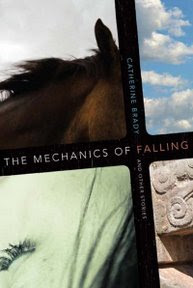
Clive was good enough to take the time, read my review, email me a little compliment, and submit to some unorthodox interview questions. Here’s what he said in case you’re interested:
"Thanks for your insightful review of
Mainline to the Heart. I've been quoting you
at readings: 'not for the faint of heart...
unlike other Beat poems, this volume is edgier
and raw...some may find the images unsettling,
but it is this nature that will encourage readers
to critically rethink their world view and examine
their environment with new eyes.'"
I think that’s one of the best compliment’s I’ve received. Thanks again, Clive; You made my day.
Without further ado, let’s see what Clive Matson had to say:
1. Do you have any obsessions that you would like to share?
Do I have any obsessions! Yes, there’s a flow of passion and unknown and archetypical images running through my body, and I’m obsessed with it. I sense a tide that’s much, much larger than the conscious mind can ever conceive. For some people this awareness might start with the realization that the body is an antennae, for others with the psychological truth that emotions reside in the body. For me this huge stream came into awareness through use of marijuana, hard drugs, and psychedelics. Mainline to the Heart and Other Poems 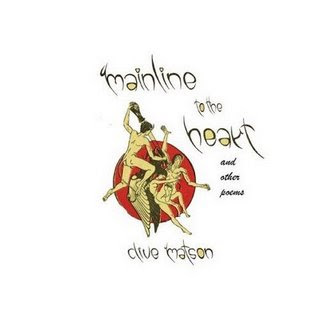
Today, the tide seems inconceivably larger than emotions, far larger than what antennae can pick up, and much more stretchable than however drugs are able to expand our consciousness. Whenever I touch it I am in awe. At least for a split second, until I’m struggling with whatever wave is kicking spindrift into my face. I am small and it’s immeasurably large, some surprise that I don’t drown. But I can naturally access only a droplet at a time.
Chalcedony, though, (Chalcedony’s First Ten Songs, Minotaur Press, 2007) lives fully in that tide. She doesn’t have much patience for those of us who don’t, especially her boyfriend. She takes him to task, often, for his cluelessness. Sometimes I think I’m the real target of her rants. “Don’t you know you have to cry?” she yells, “Can’t you remember for even five minutes? For one minute?” “You don’t know how much you’re loved.”
2. Most writers will read inspirational/how-to manuals, take workshops, or belong to writing groups. Did you subscribe to any of these aids and if so which did you find most helpful? Please feel free to name any “writing” books you enjoyed most (i.e. Bird by Bird by Anne Lamott).
My how-to-write tutorial, Let the Crazy Child Write! (New World Library, 1998), has as its precedent Dorothea Brande’s Becoming A Writer (1934). Her overwhelming thesis, borne of a time when the unconscious was first coming into parlance, is that all knowledge is contained in the unconscious. Schools and universities would disappear from the planet as soon as this perception spread. This, obviously, did not happen. We’re still reading texts and going to lectures.
But, not to diminish Dorothea Brande’s thought, the book is full of practical exercises. “Morning Pages,” for one, the signature exercise in The Artist’s Way, originated in the 1930s with Brande. And we do still need the conscious mind: it’s our doorway to understanding these principles. Or indeed, anything about the world. Or, indeed, anything.
The power of this conception can push back the editorial and critical voices in our minds. This can be extremely important when those voices become overbearing, which they are wont to do. Writing straight from that unconscious tide, from the creative unconscious, especially when we don’t have the slightest idea what is coming next, gives us a wealth of raw material. We can shape and extrapolate this material.
If the critical voices had their way, though, they’d stop the process. It’s too messy! It’s too unformed! It’s too revealing! It’s embarrassing! It’s disgustingly rough! Hard for the conscious mind to understand that the tide is where our creativity starts. And the tide is huge. It’s responsible for 99 percent (or, according to some figures, a lot more, eight factors of ten more) of the human brain’s activity, and contains all our writing impulses, all our stories, all our native poetic images. Learning to write is akin to learning to swim. And the water, at first, may not feel very comfortable.
3. Poetry is often considered elitist or inaccessible by mainstream readers. Do poets have an obligation to dispel that myth and how do you think it could be accomplished?
I couldn’t agree more that our poetry should be accessible. I do believe the only poetry that works over time is direct and totally understandable. Poetry’s ancient and continuing role is to carry our culture from generation to generation, and we don’t join that tradition if our primary impulse is to show off our brilliance. Or to be witty. Or to make money. We would do well, I believe, to join the tradition with full humility.
Today, of course, this role is debased, but less than one might think. It seems so debased partly because of limited definitions of “poetry.” Advertising fits several definitions of poetry very well, and it certainly carries much of the culture. Spoken Word is totally accessible, and it’s poetry, and it’s carrying the culture for many of our young people. Same for rap.
The reading public is correct, though: what is termed “mainstream” poetry is often inaccessible. The term “mainstream” is a misnomer. It’s a marketing tool, and there’s nothing mainstream about it, other than that some successful publishers and their audiences use the term. Most mainstream poetry is oblique lyrical poetry, and it’s generally designed to be meditated on, rather than understood. But, to give it its due, we should note that mainstream poetry can be far more accessible than Language poetry, for instance, or procedural poetry.
If you read my poetry, you’ll see one way of working through this problem. And there are many ways. We should remember how accessible most of our favorite poems are, and “accessible” does accurately describe much poetry. What’s inaccessible about “rosy-fingered dawn” or “money doesn’t talk, it swears” or “the poem does not lie to us, we lie under its law” or “we were very tired, we were very merry” or “watch what they do, not what they say” or “be kind to yourself” or “the pure gold baby that melts to a shriek” or “I heard a fly buzz the day I died” or “mango warmth fills my belly”?
4. When writing poetry, prose, essays, and other works do you listen to music, do you have a particular playlist for each genre you work in or does the playlist stay the same? What are the top 5 songs on that playlist? If you don’t listen to music while writing, do you have any other routines or habits?
This world I swim in has its own inclinations, and it’s always changing. The best I can do is be open to whatever fits. I’m playing Brahms’ songs right now, and my favorites include Terry Riley, RJD2, Leonard Cohen, Hindemith, Bach, Mozart, Beethoven, Muslim Gauze, Nine Inch Nails, Eve, John Coltrane, Steve Reich, and so many others. Sometimes I’ll get in a groove and play the same album over and over. Then, on a whim, I’ll change my selection. At that moment the universe itself seems to change.
Sometimes the music comes as counteraction to what I’m doing, sometimes it augments the writing, sometimes … I have no idea what the relationship might be. And sometimes it has nothing to do with what I’m writing. Often any music can serve to create a bubble around me, and inside it I can hear what the muse is saying.
5. In terms of friendships, have your friendships changed since you began focusing on writing? Are there more writers among your friends or have your relationships remained the same?
Voltaire says, “Writing is music of the soul.” This seems a cue to give one’s writing total respect. It has taken me years and years and years to understand that the honor it earns in my inner world should also be given in the outer world. And by my friends. I have gradually sifted out of my life those who do not hold that deep respect. And I treasure those who do. Some are writers themselves, and some are not.
6. How do you stay fit and healthy as a writer?
I hike, I play basketball and table tennis, I believe in vigorous physical exercise, I meditate an extreme amount — some variation of Vipassana – and lately I’ve become a convert to Jin shin jyutsu. I eat organically as much as I can afford to and I’m as honest in my relations as I am able.
7. Do you have any favorite foods or foods that you find keep you inspired? What are the ways in which you pump yourself up to keep writing and overcome writer’s block?
I don’t “pump up” to write. It’s more like I sink into myself to write, and what’s needed is quiet space. The bubble that music creates around me in a crowded room will do just fine.
Of course, our own passions can pump us up. And then, well, all bets are off. And whatever edible object comes into view might just possibly increase the flow.
8. Please describe your writing space and how it would differ from your ideal writing space.
I like to be mobile! My preferred writing space is bed, before or after making love. I have a friend I have long conversations with, and often some funny or gripping lines come up. I’ve learned to keep a notebook by the phone, and to bring a notebook when we talk elsewhere, and I write down the lines. At workshops I like to take my notebook to the car, tilt the seat back, roll down the windows and moon roof until just the right amount of sun comes in and just the right amount of wind blows through. Long ago Diane di Prima said she likes traveling, because when you travel “wind blows through your head.” That’s exciting.
9. What current projects are you working on and would you like to share some details with the readers?
Chalcedony has written more than 90 songs. She writes them rough and quick, and I spend a lot of time re-writing them. This requires diving into the poems, swimming with them a while and feeling out their essence. She lives in that ocean of the unconscious. She’s doesn’t know anything else, she’s totally at home in the world of primordial images and raw passion, and her view of the world is utterly her own. Archetypical and strong.
The poem I’m working on now, Song 26, was written in 2005. It took me a while to realize that Chalcedony was telling her boyfriend she wants to merge with him, and she wants him to do the same. She’s sure that’s the primary impulse of love. She doesn’t care what other people think about that, and, while I’m her servant, neither to I. She doesn’t even care what I, her scribe, might think privately. I’ll write her strongest case, and, as I’m currently nearing the finish, I might be persuaded she is correct.
She often has fights with her boyfriend. She’ll rant at him, taking him to task for not understanding love and its permutations. She’s pretty sure we’re all in love, all the time, boundariless and passionate love. She gets on our case when we don’t acknowledge this. Being her scribe is quite a journey. I get to play with a different consciousness and at the same time I’m titillated that others might find Chalcedony’s songs entertaining and valuable. But more important, the world becomes a very rich place, and my preconceptions about it are challenged by the hour. Or by the minute.
Clive Matson arrived on the Lower East Side of New York City in 1960, a fresh-faced adolescent with a blank notebook under his arm. He quickly fell in with the Beat Generation – his first event was a reading at the Tenth Street Coffeehouse, where he met Allen Ginsberg, Gregory Corso, and Diane di Prima.
The proto-Beat Herbert Huncke became his second father, and Matson was captivated by John Wieners’ poetry and subsequently by Alden Van Buskirk’s. Diane di Prima published Matson’s first poems, and in the introduction John Wieners wrote, “One wonders about the nature of love in these poems. Are they vicious, or not?”
Matson ultimately emerged drug-free and healthy gave him full appreciation for 1960s passion and honesty. These qualities are crucially important, he thinks, for the current era. “Coming to terms with my youthful, energetic voice has been a challenge,” he admits. “It helps that I hear, in these poems, both an urgent need to connect and full cognizance of the difficulties.”
Don’t forget my giveaways:
1 copy of Rubber Side Down Edited by Jose Gouveia, here; Deadline is May 15 at 11:59 PM EST
2 copies of The Last Queen by C.W. Gortner, here; Deadline is May 22 at 11:59 PM EST
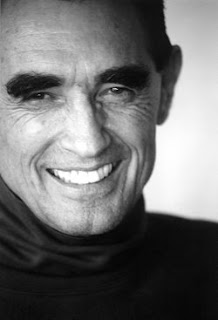

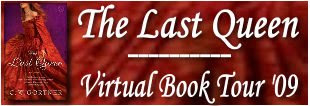

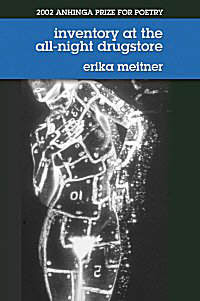



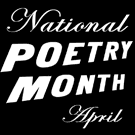









 Welcome to the April
Welcome to the April 



